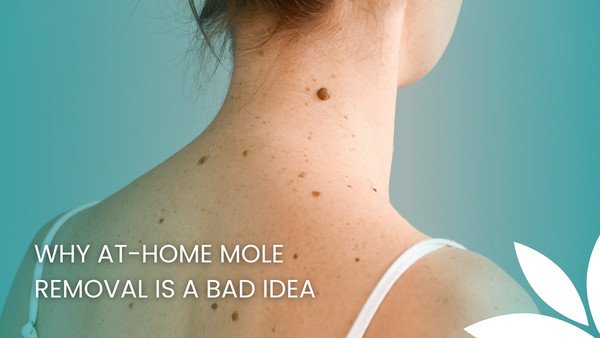There are a lot of things that you can DIY at home, but mole removal is not one of them. People removing their moles at home is one of the estheticians’ worst nightmares and it could be yours, too, if you attempt to do it without the proper tools and care.
You can possibly remove the moles but there’s a possibility that an infection will ensue and delay the healing process and worse, increase the chances of scarring. If you don’t want to damage your beautiful skin, might as well leave it to the hands of the professionals.
Besides, before getting your mole removed, you need to consult a skin specialist. Reading about whether you should do it or not on the internet is barely a good idea. To protect your skin from an unwise at-home mole removal, seek the advice of skin experts instead.
What are moles?
Moles are small, dark spots that may develop in various colors, shapes, and sizes. They are caused by a concentration of cells that produce melanin, which is the pigment that gives skin its color. While most moles are harmless and do not require any treatment, it is important to have any new moles or changes in existing moles examined by a healthcare professional.
Some people have moles at birth while some develop them during infancy. Most people have around 10 to 40 moles that gradually appear from childhood to adolescence. These may change in appearance or even fade as time goes by.
In general, most moles are harmless and aren’t considered a health hazard. But in rare cases, moles can become cancerous. It’s best to be aware of the changes in your moles, especially their size. You might also want to be conscious of other pigmented patches on your skin as it’s important in detecting early signs of skin cancer, especially malignant melanoma.
Different Types of Moles
The mole you perhaps usually see on most people is a small brown spot. However, did you know that there are different colors, shapes, and sizes of moles? Moles can differ in:
◉ Color and Texture – Other than brown, moles can also be tan, black, blue, red, or pink. The texture can be smooth, wrinkled, flat, or raised. Some even have hairs growing from them.
◉ Shape – The usual moles you see are circular in shape however, there are some moles that are oval.
◉ Size – Some moles are really small like a tiny dot while some are quite striking. That’s because some moles are usually less than 6 mm or 1/4 inch in diameter. That’s about the size of a pencil eraser! Those born with congenital nevi, meaning birth moles, may be bigger in size and usually cover a part of their face or anywhere in the body like the torso or a limb.
Where do moles usually grow?
Moles can be unpredictable. They develop randomly anywhere on your body. Some even grow up without realizing they have a mole on a certain part of their body.
Some moles can develop on the scalp, armpits, under the nails, between fingers and toes, on the chest, buttocks, base of the foot, and such. In some cases, moles come and go or fade away over time. Changes in adolescence, pregnancy, or hormones can shift the size and color of some moles.
How to Know if Your Mole Needs to be Removed
As previously mentioned, in rare cases, some moles may be an indication of skin cancer. There are some things that you need to look out for in this case. You should check the mole if there are any changes in its size, color, shape, or height. These are the things that you should watch out for:
◉ Asymmetrical shape – If one half of the mole is unlike the other half, meaning they have different shapes, you should probably be concerned. Moles are usually round or oval in shape. Anything other than that might spell trouble.
◉ Border – If your mole has irregular, notched, or scalloped borders, you need to have it checked by a skin expert. If your mole is located somewhere you can’t look on your own, let someone take a look at it and take a picture or describe it for you.
◉ Color – Other than a change in size, be cautious of your mole’s change in color. Moles that have many colors or have an uneven color are usually not a good thing. It’s best to keep a tab on your moles by taking a photo every week and checking if there are any significant changes.
◉ Diameter – If your mole grows larger than 6 millimeters, take note of it. If it keeps getting bigger, you’ll know it’s time to consult a skin specialist.
◉ Evolving – If all these things are happening all at once, it’s best to seek professional help. Moles are known to evolve and develop new signs and symptoms that may include itchiness or even bleeding.
The Risks of Removing Moles with Home Remedies
Have you been keeping track of your mole? Did you notice any changes to its size, shape, or color? If so, looking to the internet to find tutorials on a home mole removal procedure is a bad idea. That’s a job for a dermatologist, not a 5-minute skim on a sketchy internet how-to blog.
These are some of the risks that you may encounter if you pursue using home mole removal remedies:
1. Burn or scar your skin
Some people burn off their mole with apple cider vinegar or iodine. This unproven method can burn or worse, scar your skin for life. Doing this dangerous procedure may leave you with a burn mark, scar, or even skin discoloration.
2. Get an infection
There are dangerous methods that require using scissors or razors to cut off a mole. Getting a small paper cut hurts so much, how much more is a cut from a scissor or razor? This extreme method will not only wound your skin but you might also get infected. Exhale a Day Spa offers safe and professional treatments to remove your moles with minimal scarring or risk of infections and other side effects.
3. Remove a benign mole incorrectly
There’s still a chance that the mole you’re removing may be a sign of skin cancer. The only way to know this is to consult an expert and undergo an exam. Instead of cutting it off or removing it with home remedies, you might want to treat it the right way.
4. Spend lots of money on counter-effective OTC treatments
There are a lot of OTC removal creams available from the pharmacy but the thing is, these products can increase the risk of keloid developing on your skin. Keloids are large, raised scars that can grow bigger and more noticeable than the mole itself.
What is the safe way to remove a mole?
One way to safely remove a mole is through Lamprobe treatment. This is a therapeutic procedure that uses a computer-controlled device to deliver a controlled amount of energy to the skin. This energy is used to treat a variety of skin conditions, including benign moles, skin tags, milia, warts, and sebaceous hyperplasia.
The energy destroys the targeted cells without harming the surrounding tissue, allowing the damaged area to heal without scarring. Lamprobe treatments are quick, comfortable, and safe, making them an excellent option for those seeking effective, non-invasive treatment.
Other treatments may also involve:
◉ Laser removal – Some moles can be removed using laser treatment. This treatment uses light energy to break down the pigment within the mole. This is a great option for those with moles on their face as there’s less risk of scarring.
◉ Shave removal – Moles that bulge from the skin is often removed using shave removal treatment. A local anesthetic will be used to numb the area being treated and a scalpel will be used to shave off the protruding mole. This procedure is relatively simple and painless.
◉ Excision removal – Another way of removing a mole is by excision. This also includes being under local anesthetic and will require a small stitch in the skin after the procedure. The small scar will fade over time.
If you have a mole that you want to get rid of, have it checked first and leave the skin professionals to do their job so you can get the best treatment possible.
The key here is protecting and preserving your skin. If you think you can save money by removing your mole on your own at home, think again. You’re actually risking spending a lot of money trying to fix irrevocable damage.
Keep a tab on your mole and see if there are any changes in its size, shape, and color. It’s better to nip the problem in the bud before it turns into something more serious and problematic.
If you are not sure whether or not your mole is malignant, visit Exhale a Day Spa. You can consult with a professional and even get a Lamprobe treatment if you want the mole removed.


Recent Comments